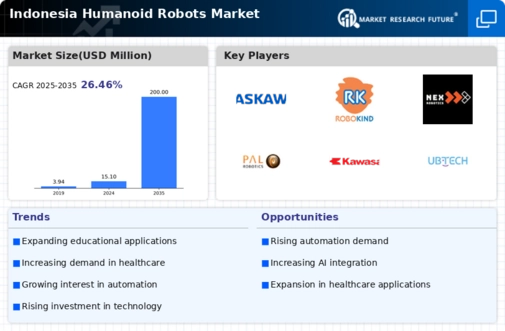The Indonesia Humanoid Robots Market presents a dynamic competitive landscape characterized by various players striving to gain significant market share. The ongoing technological advancements and increasing demand for automation in sectors such as education, healthcare, and entertainment have catalyzed the interest of both local and international companies in the development and deployment of humanoid robots across the region. As the market expands, these companies are keen on enhancing their product offerings and establishing strategic partnerships to bolster their presence.
Emerging trends reflect a growing emphasis on creating robots that can interact with humans more naturally, thereby improving user experience and operational efficiency.
Companies are investing in research and development to innovate and cater to the specific needs of the Indonesian market, making competition increasingly fierce. Yaskawa Electric has established a notable presence in the Indonesia Humanoid Robots Market through its cutting-edge industrial robotics technology and a strong focus on automation solutions. The company is known for its exceptional engineering capabilities, reliable performance, and commitment to innovation, which have enabled it to capture a significant share of the market. Yaskawa Electric’s strengths lie in its comprehensive product range, which includes advanced humanoid robots designed for various applications such as education and industrial automation.
Its ability to deliver high-quality products, along with excellent customer support, has helped Yaskawa resonate well with local clients. Furthermore, the company's strategic partnerships with technological institutions enhance its reputation and offer opportunities for collaborative advancements in robotics.RoboKind has been making strides in the Indonesia Humanoid Robots Market, primarily focusing on developing educational robots intended to enrich learning experiences and enhance skill development. The company's flagship products, which include interactive humanoid robots designed for schools, aim to make learning engaging and cater to diverse educational needs.
RoboKind leverages its strengths in robotics by combining cutting-edge technology with curriculum-aligned programs, positioning itself as a leader in educational robotics within Indonesia. The company actively seeks collaboration with local educational institutions to improve its offerings and expand its reach. Recent mergers and acquisitions have allowed RoboKind to integrate advanced technologies into their products, further amplifying their capabilities to meet the evolving demands of Indonesian markets and establishing themselves as a robust competitor in the humanoid robotics sector.














